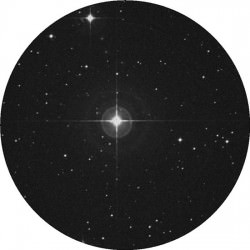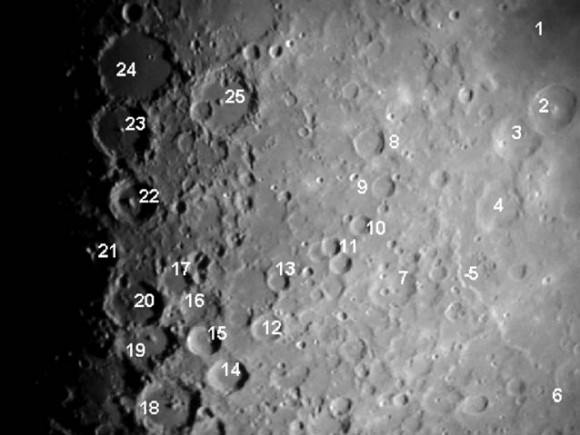Greetings, fellow SkyWatchers… Are you enjoying the typical “change of seasons” weather in your area? If skies should clear for you this weekend, we have some very nice lunar challenges along with some very interesting stars! Why not spend a little time contemplating lunacy and gathering a few photons? When ever you are ready, I’ll see you in the back yard…
May 21, 2010 – Today we’d like to wish a happy birthday to Nils Christofer Duner. Born in 1839, this classical astronomer studied the rotational period of the Sun. Duner was an outstanding observer and made 2,679 measurements of 445 double and multiple stars. He also specialized in observing the spectra of red stars, and later made a series of measurements of the Doppler shift caused by solar rotation. As you know, one of our own Sun’s main ingredients is helium. If you would like to see a helium-rich star, look no further tonight than Alpha Virginis See Spica— Spica . As the 16th brightest star in the sky, this brilliant blue-white ‘‘youngster’’ appears to be about 275 light-years away and is about 2,300 times brighter than our own Sun. Although we cannot see it visually, Spica is a double star. Its spectroscopic companion is roughly half its size and is also helium rich.
Now, let’s have a look at the Moon! Tonight’s challenges are craters Cassini and Cassini A, which come into view just south of the black slash of the Alpine Valley.
The major crater spans 57 kilometers and reaches a floor depth of 1,240 meters. Your assignment, should you decide to accept it, is to spot the central crater A. It only spans 17 kilometers, yet drops down another 2,830 meters below the primary crater’s floor!
 May 22, 2010 – Let’s begin the day by honoring the 1920 birth on this date of Thomas Gold, an astronomer known for
May 22, 2010 – Let’s begin the day by honoring the 1920 birth on this date of Thomas Gold, an astronomer known for
proposing the ‘‘steady-state’’ theory of the universe; for explaining pulsars; and for giving the magnetosphere its name. Gold was also an auditory research genius. In his interview with D.T. Kemp he stated: ‘‘I’m a compulsive thinker, I never turn my brain off, I’ve never in my life complained of being bored because I’m constantly thinking about some problem, mostly physics I suppose. A problem is always on my mind—evidently even in my sleep because I often wake up with a solution clearly spread out.’’
Tonight let’s take a long Moonwalk together and do some major crater exploration. Try using mid-range magnification in your telescope and see how many of the features you can identify:
(1) Sinus Asperitatis, (2) Theophilus, (3) Cyrillus, (4) Catharina, (5) Rupes Altai, (6) Piccolomini, (7) Sacrobosco, (8) Abulfeda, (9) Almanon, (10) Taylor, (11) Abenezra, (12) Apianus, (13) Playfair, (14) Aliacensis, (15) Werner, (16) Blanchinus, (17) Lacaille, (18) Walter, (19) Regiomontanus, (20) Purbach, (21) Thebit, (22) Arzachel, (23) Alphonsus, (24) Ptolemaeus, and (25) Albategnius.
May 23, 2010 – If you like to venture to the lunar surface tonight, we can enjoy a strange, thin feature that’s a nice challenge! Look toward the lunar south, where you will note the prominent rings of craters Ptolemaeus, Alphonsus, Arzachel, Purbach, and Walter descending from north to south. Just west of them, you’ll see the emerging Mare Nubium.
Between Purbach and Walter, you will see the small, bright ring of Thebit, with a crater caught on its edge. Look further west to spot a long, thin, dark feature cutting across the mare. Its name? Rupes Recta , better known as the ‘‘Straight Wall,’’ or sometimes Rima Birt. The Straight Wall is one of the steepest known lunar slopes, rising around 366 meters from the surface at a 41 degree angle. Be sure to mark your lunar challenge notes and visit this feature again!
 If you’d like to take a look at a ‘‘habitable zone,’’ look no further than AX Microscopii (RA21 17 15 Dec – 38 52 02). AX is a dwarf red flare star, which resides only 12.9 light-years from us. Although it might not seem that important, it is the target of interferometric studies searching for planets that may have formed in habitable zones around stars similar to our own. Even though AX is slightly smaller than Sol, this cool main sequence star might in fact be inhospitable, due to its daily flare activity.
If you’d like to take a look at a ‘‘habitable zone,’’ look no further than AX Microscopii (RA21 17 15 Dec – 38 52 02). AX is a dwarf red flare star, which resides only 12.9 light-years from us. Although it might not seem that important, it is the target of interferometric studies searching for planets that may have formed in habitable zones around stars similar to our own. Even though AX is slightly smaller than Sol, this cool main sequence star might in fact be inhospitable, due to its daily flare activity.
Until next week? Ask for the Moon… But keep on reaching for the stars!
This week’s awesome images (in order of appearance) are: Cassini – courtesy of Wes Higgins, Thomas Gold (archival image), Lunar Photo courtesy of Greg Konkel – Annotations by Tammy Plotner, Rupes Recta courtesy of Damien Peach and AX Microscopi was done by Palomar Observatory, courtesy of Caltech. We thank you so much!





Thanks Tammy! Chuck Wood of LPOD fame would be proud of your effort this week!
How about that Jupiter loosing its Southern belt! Very strange….Maybe now I’ll be able to clearly make out the Great Red Spot in my little 4″ SC?
Un-for-tuna-nettly, we’ve been rather clouded out most of the best viewing ops this year here in No. Calif. My poor lonely telescope is just itching to get up the mountain and do some viewing! Come on clear skies!
Recently I made a lunar projection plate for one of my telescopes. This scope is a 50mm refractor I have that came from an old Naval gun bore sight (30’s-40’s era). I cut a 3″ long piece of 2″ dia black PVC tubing then used my Dremel tool to hone out the I.D. so that it fits snuggly over the permanently mounted eyepiece. Then I drilled 4 holes and inserted some old bicycle spokes into the PVC tube. I took some white foam core art board and cut a 6″X 6″ square. Then I punctured the art board at the corners with the ends of the spokes. To keep the assembly stiff I used a SS tube clamp around the spokes and PVC tubing to hold the spokes in place. Now I have a sliding white projection board for lunar studies! This scope is mounted on an old German Eq. mount that came with a 4″ reflector (ruined mirror) I picked up for free from a junk pile… NOW the trick will be to use my digital camera to take picture of the projected moon… come on clear skies!
This old refractor is a very interesting design. Made by Keuffel & Esser Co. model #5010. It has two lens with one mounted in the middle in an adjustable focus carriage. The eyepiece twists for further focusing on the crosshairs – made from Black Widow spider webbing!
I’ve been waiting for clear skies to test my invention – can hardly wait! I’ll send along some images later if you like?
Comet McNaught in the morning sky has unexpectedly brightened.
http://media.skyandtelescope.com/documents/WEB_McNaught_Path.pdf